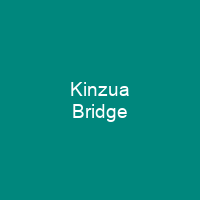The Majestic Kinzua Bridge: A Towering Wonder of Engineering
Imagine standing at the edge of a cliff, gazing up at a structure that seems to defy gravity itself—this is what the Kinzua Bridge was like in its heyday. Built in 1882 and rebuilt in 1900, this towering viaduct once held the record for being the tallest railroad bridge in the world. But how did it all begin?
Thomas L. Kane’s NYLE&W Railway laid down the first tracks on this ambitious project, which took just 94 working days to complete. The bridge was a marvel of engineering, featuring 20 towers made from patented ‘Phoenix columns’ and supported by 110 sandstone masonry piers. It was designed by Octave Chanute and built using a unique gin pole system that allowed for the construction of such an imposing structure.
But what makes this bridge truly remarkable is its sheer size—over 2,052 feet long and standing at 301 feet tall. Six of these towers were even taller than the iconic Brooklyn Bridge! It’s hard to imagine a structure that could hold such records until it was surpassed in France.
A Tale of Two Bridges
The first Kinzua Bridge, built with wrought iron, was a testament to early 19th-century engineering. However, by the turn of the century, locomotives had become heavier, and the old bridge could no longer support them. In 1900, it was dismantled and replaced with a steel structure designed by C.R. Grimm. This new bridge was built using 3,358 tons of steel at a cost of $275,000.
The construction process for the second bridge took only four months, but it too faced its challenges. The original wrought-iron towers were used as support structures, and while the bolts from the first bridge were reused, they later proved problematic due to rusting. Despite these issues, the new bridge reopened on September 25, 1900, and was able to safely accommodate heavy trains.
A Legacy of Trains and Tales
Trains crossing the Kinzua Bridge had to slow down due to vibrations caused by both the locomotive and wind. This unique experience made it a popular destination for excursion trains, with brakemen even playing tricks on train crews during their first journey over the bridge’s rooftops! The bridge still had a speed limit of 5 miles per hour, but diesel locomotives were exempt from this rule.
By 1900, the NYLE&W Railway had merged with the Erie Railroad, which became the owner of the bridge. However, by 1950, even steam locomotives could no longer cross it due to its age and weight limitations. The last commercial steam locomotive crossed the Kinzua Bridge in that year.
Despite its historical significance, the bridge’s future was uncertain until local groups intervened. In 1963, Pennsylvania Governor William Scranton signed a bill to purchase the bridge for $50,000 and create Kinzua Bridge State Park. The park opened in 1970, with new facilities and an access road built over time.
The Collapse of a Towering Wonder
Tragedy struck on July 21, 2003, when a tornado hit the bridge during construction work. The collapse was caused by high winds that shifted the center of gravity onto one side of the bridge, causing it to fail. Three people died in the collapse due to base bolt failures under wind gusts.
After the collapse, there were plans to rebuild the bridge, but Pennsylvania decided against it. Instead, they proposed using the ruins as a visitor attraction. The Knox and Kane Railroad suspended operations in 2006 due to declining passenger numbers after the bridge’s collapse.
A New Vision for Kinzua Bridge State Park
Despite its tragic end, the Kinzua Bridge still holds a special place in Pennsylvania’s history. The state reimagined the park as a destination anchored by a ‘sky walk’ viewing platform and network of hiking trails. In 2011, the Kinzua Sky Walk was opened at a cost of $4.3 million, offering visitors an opportunity to experience the bridge’s legacy from a safe distance.
Today, the ruins of the Kinzua Bridge stand as a testament to engineering marvels and natural disasters. They serve not only as a reminder of what once was but also as a symbol of resilience and innovation in the face of adversity.

The legacy of the Kinzua Bridge lives on, inspiring us with its engineering prowess and serving as a reminder of the dynamic nature of our world. Whether you’re a history buff or just curious about this towering wonder, visiting Kinzua Bridge State Park is an experience not to be missed.
You want to know more about Kinzua Bridge?
This page is based on the article Kinzua Bridge published in Wikipedia (retrieved on December 3, 2024) and was automatically summarized using artificial intelligence.







